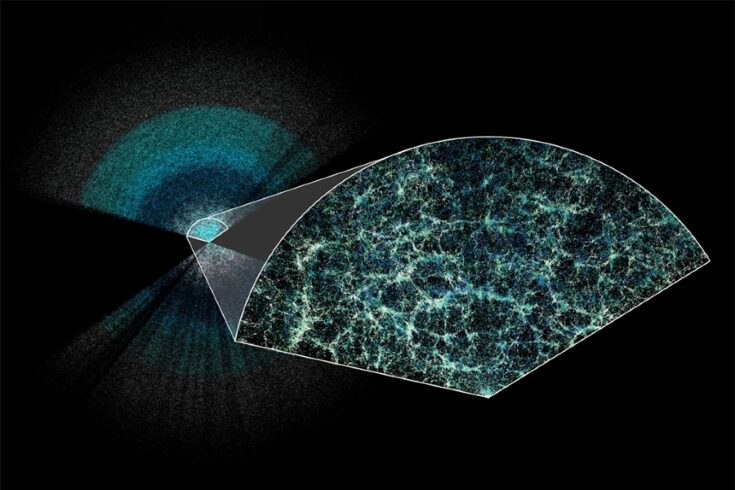DESI is a wide-reaching international collaboration led by the US Department of Energy Lawrence Berkeley Lab.
The Science and Technology Facilities Council (STFC) supports the UK component of the study, which includes Durham University, University of Portsmouth and UCL.
Map of the Universe
DESI has mapped millions of galaxies and quasars with unprecedented detail.
Its latest findings, published on the arXiv open-access archive, provide a map of the Universe that shows how it has expanded over the past 11 billion years.
This is the first time that scientists have measured cosmic expansion over such a long time period.
A light in the dark
Dark energy is the name given to a form of energy that is causing the expansion of the Universe to accelerate.
It is little understood but can be studied by tracking the expansion of the Universe as a way of measuring how it behaves.
DESI does exactly this by using thousands of specialised robots mounted in a mountaintop telescope in Arizona, which detect light from far-flung objects in space and deduce their movement over time.
Measuring how the Universe has evolved in this way also helps us to understand dark matter, which makes up most of the mass of the Universe and slows cosmic expansion.
Testing the limits
DESI has now created a 3D map of over six million galaxies showing how the Universe has changed over 11 billion years, the largest and most precise dataset of its kind.
This is the first time that scientists have measured the expansion history of the Universe with a precision better than 1%, giving the best view yet of how the Universe has evolved.
It sheds new light on the nature and effect of dark energy and it is helping scientists to test and build better models of the evolution of the Universe.
Unprecedented findings
Professor Carlos Frenk, Ogden Professor in the Institute for Computational Cosmology, Department of Physics, Durham University, and a member of the DESI team and its International Advisory Board, said:
Never before has mankind measured the basic properties of our Universe with such precision.
On the whole, the elegant model of our Universe that has emerged over the past four decades gets a clean bill of health.
And yet, there are hints in the data that perhaps the simplest possible form of dark energy – Einstein’s cosmological constant, Lambda – may not be the whole story. We will know for sure in the coming three years.
Important UK contributions
DESI is an international collaboration of more than 900 researchers from over 70 institutions around the world including several STFC-supported UK universities.
UK involvement in DESI includes Durham University, UCL and the University of Portsmouth as full member institutions, together with individual researchers at the universities of:
- Cambridge
- Edinburgh
- St Andrews
- Sussex
- Warwick
Designing and building
Durham University helped to design and build the fibre optic cable system, which funnels light onto the spectrograph.
UCL helped to design and build the telescope’s mirror optical corrector.
UK researchers have also played a key role in the analysis, modelling and interpretation of the data.
Exciting future research
Dr Seshadri Nadathur from the Institute of Cosmology and Gravitation, at the University of Portsmouth, who led parts of the analysis, said:
It’s been a major team effort and a huge amount of work to produce these amazing results.
We’ve already collected data on nearly 6.5 million galaxies and quasars in just a single year of DESI operations – already more than double what the previous largest survey managed over two decades!
There is a lot more data still to come too, and seeing these tantalising results on dark energy is a good motivator to start those analyses soon.
Entirely new science
Professor Mark Thomson, Executive Chair of STFC, said:
I am extremely proud of the support that STFC has provided to DESI and would like to congratulate all those who contributed on these remarkable results.
DESI is a hugely ambitious endeavour that only recently would have seemed like an impossible task.
Today though, we are closer than ever to understanding the nature and effects of dark energy and the evolution of our Universe thanks to widespread international and national collaboration.
Further information
DESI’s latest findings were presented in talks at the American Physical Society meeting, US, and the Rencontres de Moriond, Italy, as well as being published on the arXiv open-access archive.
More information on the DESI collaboration and these latest results can be found on the DESI and Durham University websites.
The DESI collaboration is honoured to be permitted to conduct scientific research on Iolkam Du’ag (Kitt Peak), a mountain with particular significance to the Tohono O’odham Nation.

